ARIEL ATOM 2 2006 Workshop Manual
Manufacturer: ARIEL, Model Year: 2006, Model line: ATOM 2, Model: ARIEL ATOM 2 2006Pages: 79, PDF Size: 2.5 MB
Page 51 of 79
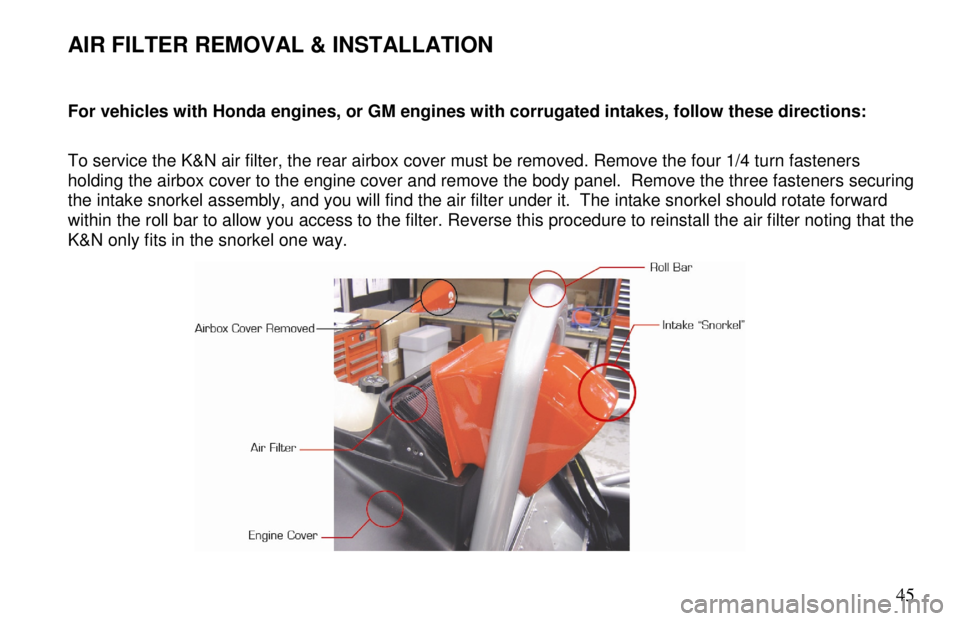
45
AIR FILTER REMOVAL & INSTALLATION
For vehicles with Honda engines, or GM engines with corrugated intakes, follow these directions:
To service the K&N air filter, the rear airbox cover m ust be removed. Remove the four 1/4 turn fasteners
holding the airbox cover to the engine cover and remo ve the body panel. Remove the three fasteners securing
the intake snorkel assembly, and you will find the air filter under it. The intake snorkel should rotate forward
within the roll bar to allow you access to the filter. Reverse this procedure to reinstall the air filter noti ng that the
K&N only fits in the snorkel one way.
Page 52 of 79

46
AIR FILTER REMOVAL & INSTALLATION (PLASTIC INTAKE)
If your car is equipped with a GM engine that was purch ased after November 2006, it may have a plastic intake
and require one additional step for removal.
Follow the previous instructions, and then remove the a ir filter retaining clip after the snorkel is removed. This
step will not require any tools.
NOTE: The Filtercharger® element must be cleaned and serviced with K&N cleaner and air filter oil per the
prescribed routine maintenance procedures as outlined in the product literature that accompanies the
Filtercharger®. For additional information, refer t o the K&N “Helpful Hints” document in your Owner’s Packet .
Page 53 of 79
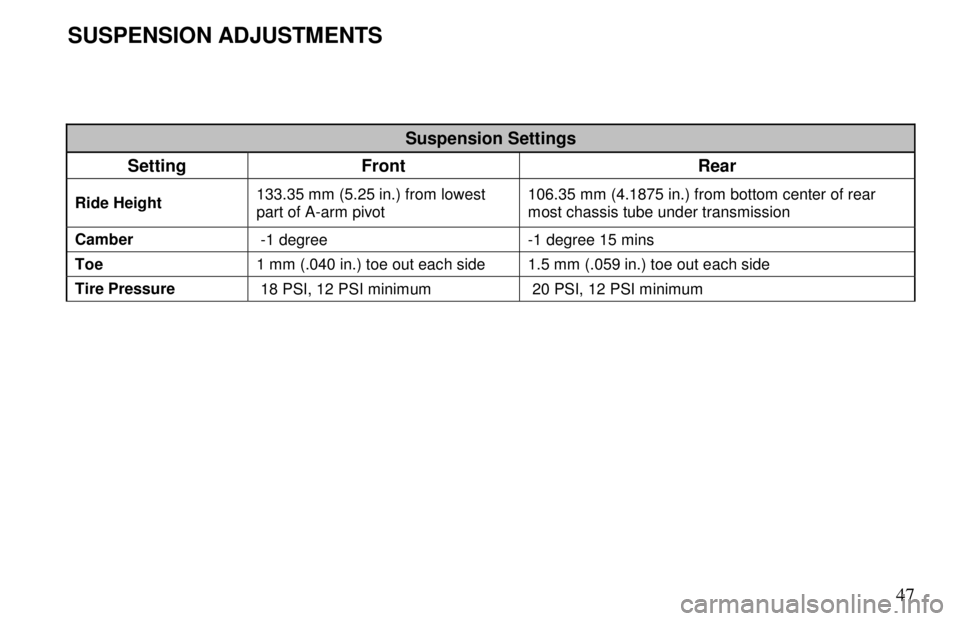
47
SUSPENSION ADJUSTMENTS
Suspension Settings
Setting Front Rear
Ride Height 133.35 mm (5.25 in.) from lowest
part of A-arm pivot 106.35 mm (4.1875 in.) from bottom center of rear
most chassis tube under transmission Camber
-1 degree -1 degree 15 mins Toe 1 mm (.040 in.) toe out each side 1.5 mm (.059 in.) toe out each side Tire Pressure
18 PSI, 12 PSI minimum 20 PSI, 12 PSI minimum
Page 54 of 79

48
A-ARM ADJUSTMENT
A-Arm adjustments are made with the double threaded "adjustment thimbles" (see photograph) which are
located on both the front and rear upper A-arms for u se in adjusting wheel camber. The same mechanism can
be found at the rear lower A-arm for toe adjustment . The adjustment thimbles are secured with lock nuts whi ch
must be re-tightened after any adjustments are made. The vehicle must be re-aligned after any camber
adjustment is made.
Page 55 of 79
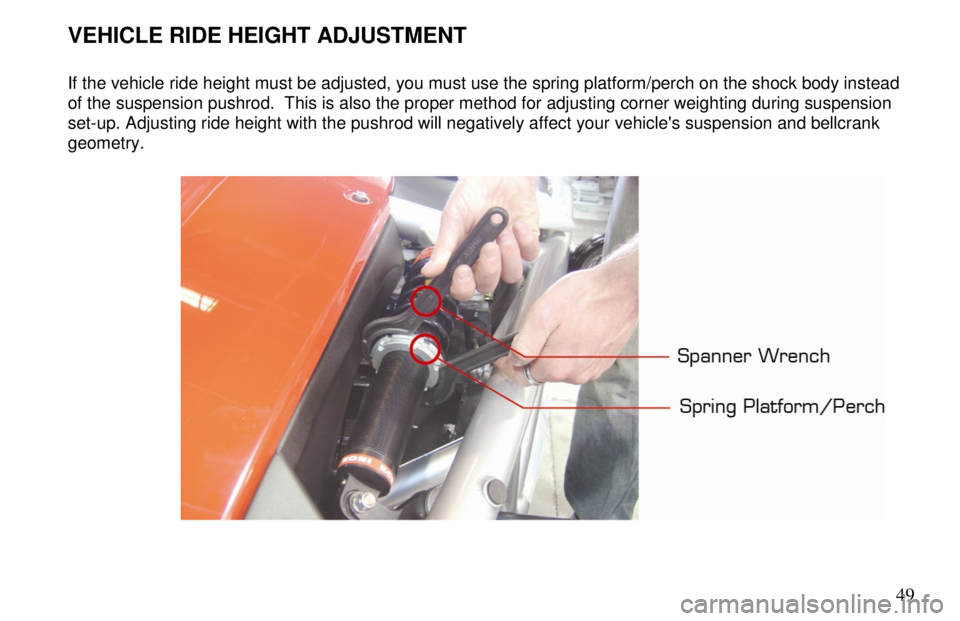
49
VEHICLE RIDE HEIGHT ADJUSTMENT
If the vehicle ride height must be adjusted, you must use the spring platform/perch on the shock body instead
of the suspension pushrod. This is also the proper method for adjusting corner weighting during suspension
set-up. Adjusting ride height with the pushrod will ne gatively affect your vehicle's suspension and bellcrank
geometry.
Page 56 of 79
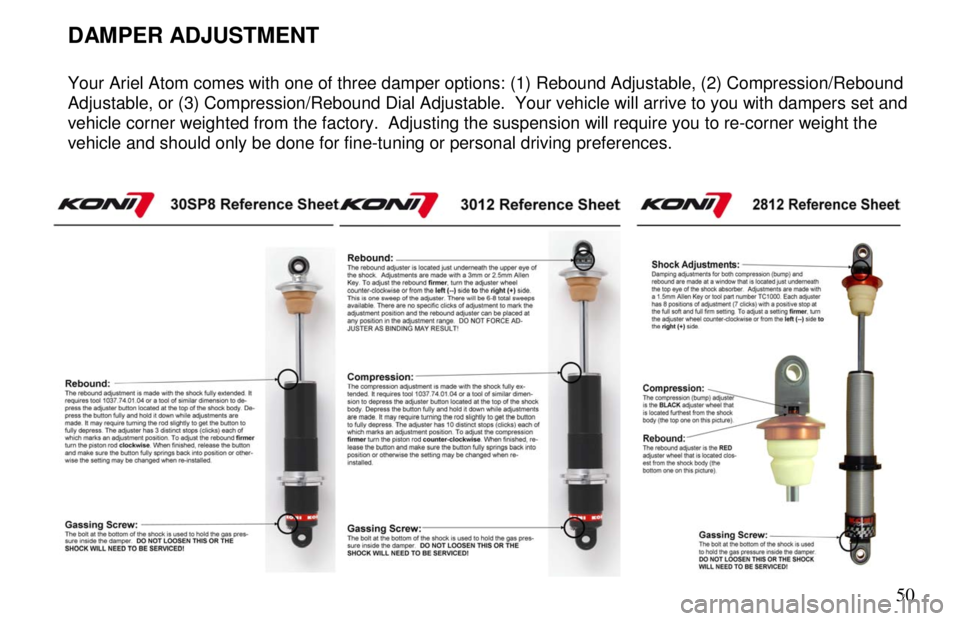
50
DAMPER ADJUSTMENT
Your Ariel Atom comes with one of three damper options: (1) Rebound Adjustable, (2) Compression/Rebound
Adjustable, or (3) Compression/Rebound Dial Adjustable. Your vehicle will arrive to you with dampers set and
vehicle corner weighted from the factory. Adjusting t he suspension will require you to re-corner weight the
vehicle and should only be done for fine-tuning or pe rsonal driving preferences.
Page 57 of 79
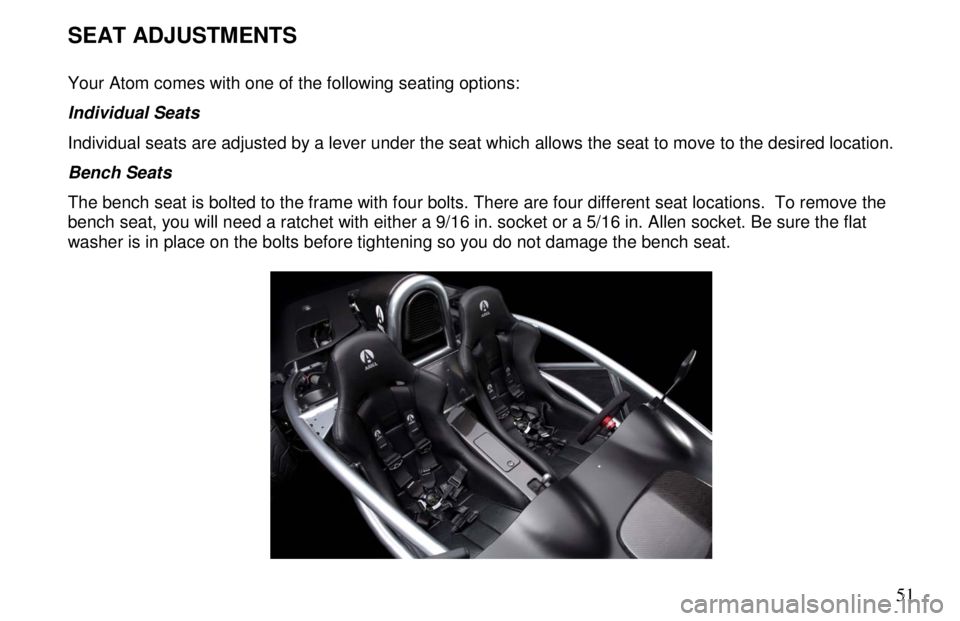
51
SEAT ADJUSTMENTS
Your Atom comes with one of the following seating options:
Individual Seats
Individual seats are adjusted by a lever under the seat which allows the seat to move to the desired location.
Bench Seats
The bench seat is bolted to the frame with four bolts. There are four different seat locations. To remove the
bench seat, you will need a ratchet with either a 9/16 in. socket or a 5/16 in. Allen socket. Be sure the flat
washer is in place on the bolts before tightening so yo u do not damage the bench seat.
Page 58 of 79
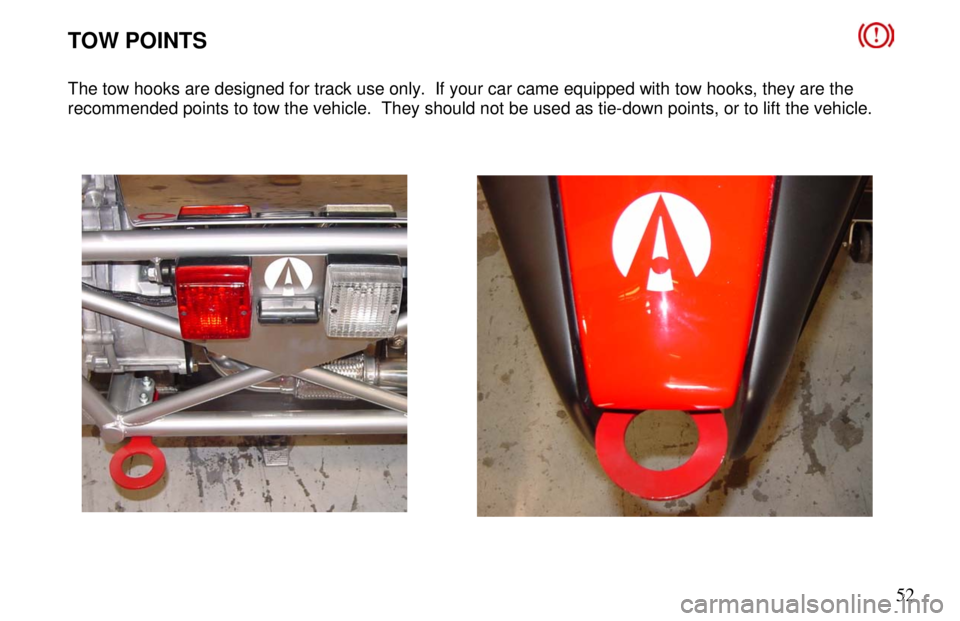
52
TOW POINTS
The tow hooks are designed for track use only. If your car came equipped with tow hooks, they are the
recommended points to tow the vehicle. They should not be used as tie-down points, or to lift the vehicle.
Page 59 of 79

53
MAINTENANCE SCHEDULES
The following schedules describe the maintenance require d for your Atom. Your vehicle is dependent on these
services to retain its safety and dependability. Refer to the Fluid Level/Fluid Type sections on pages 35-36
and the Replacement Part sections on pages 59-62 for qu antities and product types. Refer to the specific
component sections for locations, descriptions and/or accessing instructions.
Schedule I: General Reference
Refer to this schedule as an overall guide for perfor ming specific operations at specific mileage intervals.
Schedule II: Before Every Track Event
Follow the steps in this schedule before every track even t. Follow this schedule in conjunction with the other
schedules.
Schedule III: Initial 50 Miles (80 km)
Follow the steps in this schedule immediately following the initial 50 miles (80 km) of driving your vehicle.
Schedule IV: Initial 300 Miles (480 km)
Follow the steps in this schedule immediately following the initial 300 miles (480 km) of driving your vehicle.
Schedule V: Every 1,000 Miles (1,600 km)
Refer to this schedule at every 1,000 mile (1,600 km) interval of driving your vehicle.
Follow this schedule in
conjunction with schedules I & II.
Page 60 of 79

54
MAINTENANCE SCHEDULE FOR THE ARIEL ATOM 2
SCHEDULE I: GENERAL REFERENCE
Component Service/Operation
� Engine Oil
Check before every track event or every 1,000 miles (1,600 km). Change as necessary. � Engine Oil Filter
Replace during every oil change. � Engine Coolant
Check before every track event. Replace every 30,0 00 miles (48,000 km). � Supercharger
Aftercooler Coolant Check before every track event. Replace every 30,0
00 miles (48,000 km). � Air Filter Check before every track event. Clean and oil ever
y 5,000 miles (8,000 km). The Filtercharger®
element must be cleaned and serviced with K&N clean er and air filter oil per the prescribed routine
maintenance procedures as outlined in the product l iterature that accompanies the Filtercharger®. � Spark Plugs
Inspect before every track event and change if nece ssary. � Transmission Fluid
Inspect for leaks before every track event; change every 10,000 miles (16,000 km). � Brake Fluid
Inspect levels, condition, and any leakage before e very track event. � Brake Rotors Replace when thickness decreases to 19mm, when puls
ation is noted, or if cracking or other physical
damage is found during inspection. Refer to the br ake bedding procedures on page12. � Brake Pads Inspect for pad damage, thickness issues or deterio
ration before every event. Replace brake pads
when brake rotors are replaced. Refer to the brake bedding procedures on page12. � Brake Hoses &
Lines Inspect brake lines for rubbing, scraping, or any d
amage. � Fuel Lines &
Connections Inspect lines for rubbing or scraping before every
track event. � Exhaust System Use a wrench to inspect flange bolts for tightness
every 5,000 miles (8,000 km), check gaskets at
this time. � Tires
Inspect tires for proper pressure and tread wear be fore and after every track event. � Wheels Check wheel nut torque after the first 50 miles (80
km) of operation and before every track event
thereafter. Ensure lug nut torque is 80 ft-lbs. � Drive Belt
Check belt for cracking or abnormal wear every 3,00 0 miles (4,800 km). � Rod Ends Inspect rods ends on Push Rods, Steering Rods, and
A-Arms for any signs of fatiguing or wear,
replace if parts appear worn. Verify that all chec k nuts are tight on all rod ends.